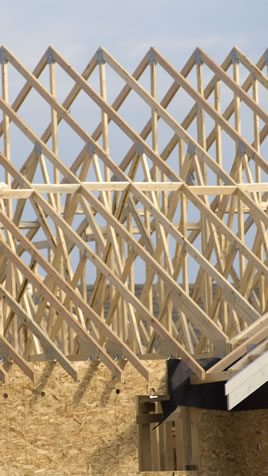Product description
Wood trusses are engineered wood products used in residential and non-residential construction. A wood truss is a structural frame that relies on a triangular arrangement of shorter lengths of lumber transferring the loads to reaction points.

This arrangement gives trusses a high strength-to-weight ratio while replacing traditional larger solid-wood rafters in roofing structures or floor joists in floor assemblies.
Technical information
Trusses are relatively cheap and easy to manufacture. They are also simple to erect on site. Light-frame wood trusses are prefabricated by pressing steel truss plates into wood members that are pre-cut and assembled in a jig. They are typically custom made. The building designer or builder contacts the truss fabricator, who will supply a truss layout and a structural design of each significant element of the roof or floor system.
Most trusses are fabricated using visually graded lumber or machine stress-rated (MSR) lumber. Within a single truss, several grades of MSR lumber are used, depending on the design requirement of each lumber member as calculated according to engineering principles.
In pitched chord trusses, which are typically used in roof assemblies, the top chords meet at the apex of a triangle. In parallel chord trusses, used for flat roofs or floors, the top and bottom chords are arranged in parallel. Complex and intricate shapes specified by building designers can also be produced. Light-frame trusses can span up to 20 m (60 ft), although longer spans are also feasible.